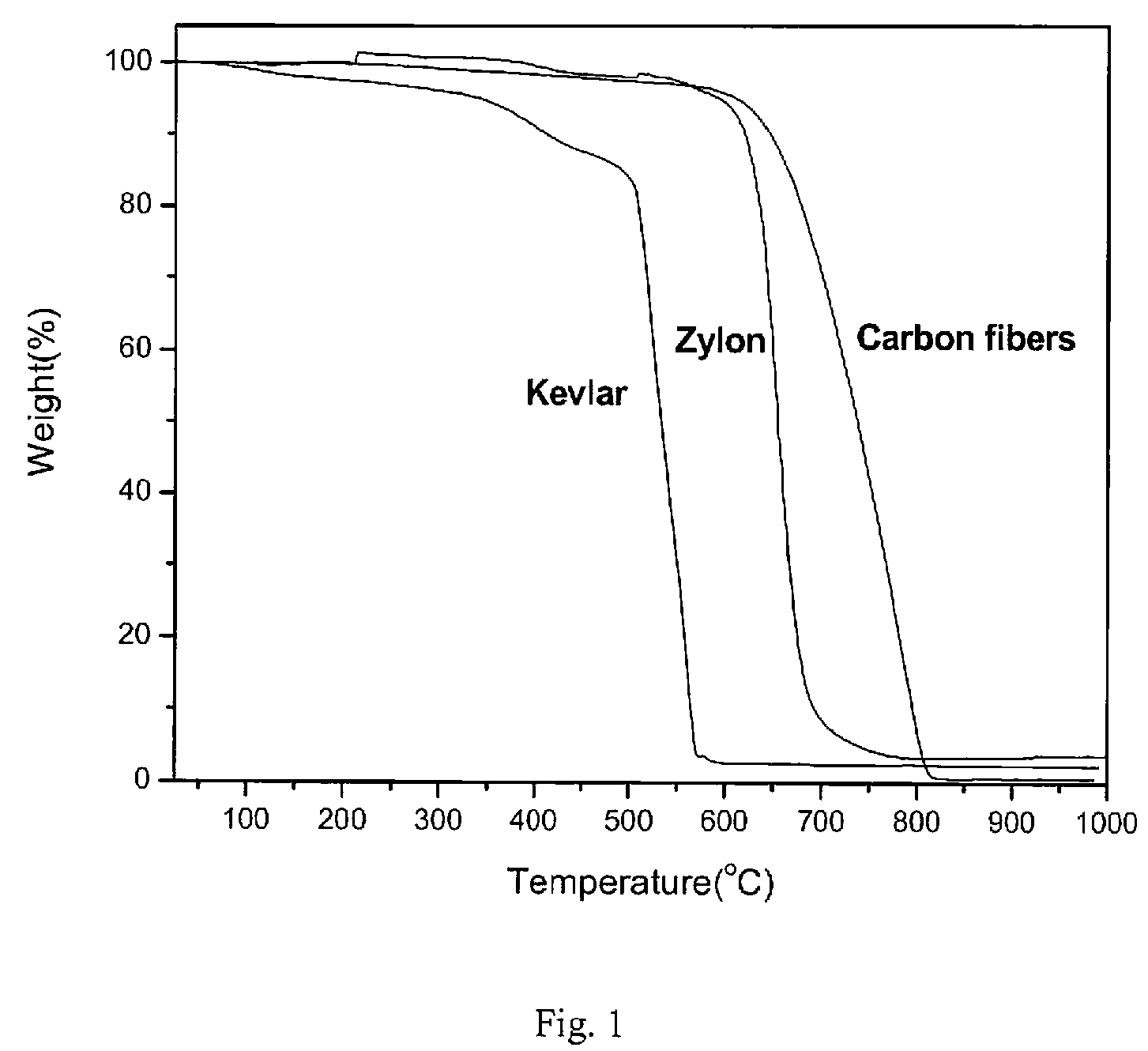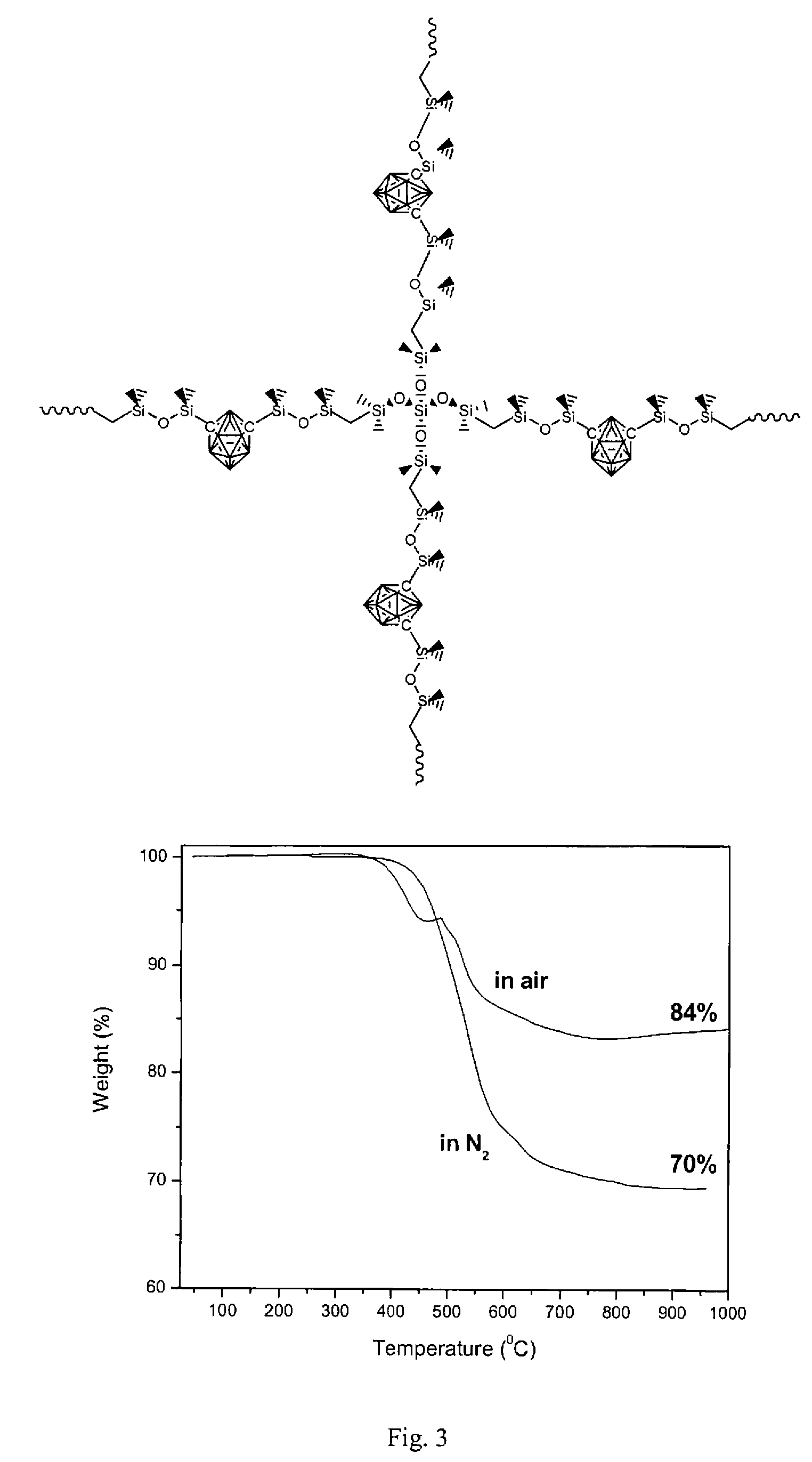Coating of organic fibers with siloxane-carborane polymers
a technology of siloxanecarborane and organic fibers, applied in the directions of organic chemistry, transportation and packaging, yarn, etc., can solve the problem of catastrophic decomposition
- Summary
- Abstract
- Description
- Claims
- Application Information
AI Technical Summary
Benefits of technology
Problems solved by technology
Method used
Image
Examples
example 1
[0043]TGA evaluation of thermo-oxidative protection of ZYLON® fiber / tows on application of a single coating using a 0.05 M solution of (1) in CH2Cl2—Fiber drying: ZYLON® fiber / tows were severed into small pieces of ˜11 mg each and were dried in a TGA instrument at 400° C. for 4 h under an atmosphere of nitrogen. (Note: A darkening of the yellowish tow is observed on drying. The dried fiber had a purplish hue to it. Some deleterious effects on the tow from the reaction at a higher temperature of residual moisture and polyphosphoric acid in it cannot be discounted). A 15% loss was observed in the weight of the ZYLON® fiber / tow after drying.
[0044]Preparation of the coating solution: 0.114 g of polymer 1 was dissolved in 5 mL of CH2Cl2 to yield a 0.05 M solution of the material.
[0045]Coating of the ZYLON® fiber tows with the PCSA solution and the curing of the deposited coating: The cut pieces of ZYLON® fiber / tows were immersed for 5 minutes in the PCSA solution taken in a 5 mL vial. Af...
example 2
[0047]TGA evaluation of thermo-oxidative protection of ZYLON® fiber / tows on application of three coatings using a 0.2 M solution of 1 in CH2Cl2—The weight of the ZYLON® fiber / tow tested was 0.0117 g. 0.456 g of polymer 1 was dissolved in 5 mL of CH2Cl2 to yield a 0.2 M solution of the material. The procedure for coating with the PCSA solution and the subsequent curing of the ZYLON® fiber / tow was as in Example 1 which was repeated three times and the weight of the coating was found to be 0.003 g (25% by weight of the fiber / tow). The thermo-oxidative stability test of the coated fiber / tow was performed as in Example 1. A weight retention of 72% was obtained.
example 3
[0048]TGA evaluation of thermo-oxidative protection of ZYLON® fiber / tows on application of four coatings using a 0.2 M solution of 1 in CH2Cl2—The weight of the ZYLON® fiber / tow tested was 0.0113 g. Four coatings of the PCSA polymer was obtained as described in Example 1. The weight of the coating was found to be 0.0033 g (29% by weight of the fiber / tow). The thermo-oxidative stability test of the coated fiber / tow was performed as in Example 1. A weight retention of 78% was obtained.
PUM
| Property | Measurement | Unit |
|---|---|---|
| Young's modulus | aaaaa | aaaaa |
| temperature | aaaaa | aaaaa |
| temperatures | aaaaa | aaaaa |
Abstract
Description
Claims
Application Information
 Login to View More
Login to View More - R&D
- Intellectual Property
- Life Sciences
- Materials
- Tech Scout
- Unparalleled Data Quality
- Higher Quality Content
- 60% Fewer Hallucinations
Browse by: Latest US Patents, China's latest patents, Technical Efficacy Thesaurus, Application Domain, Technology Topic, Popular Technical Reports.
© 2025 PatSnap. All rights reserved.Legal|Privacy policy|Modern Slavery Act Transparency Statement|Sitemap|About US| Contact US: help@patsnap.com



